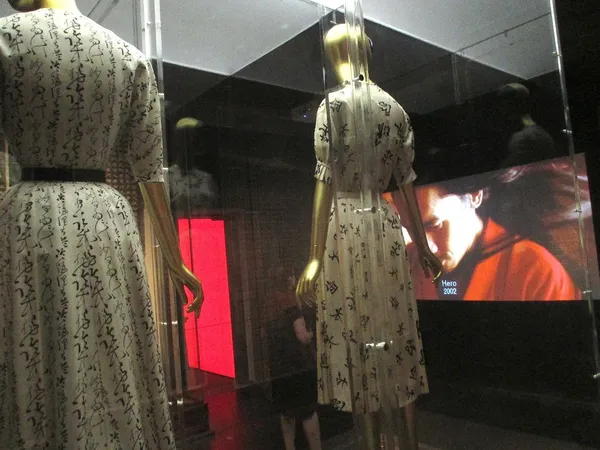 |
| Christian Dior and Coco Chanel calligraphy dresses with a clip from Zhang Yimou's Hero edited by Wong Kar Wai Photo: Anne-Katrin Titze |
With the John Singer Sargent exhibition, Sargent: Portraits of Artists and Friends, organised by the National Portrait Gallery, London in collaboration with The Metropolitan Museum of Art opening today, here is the second half of my conversation with Gay Talese on the seduction of fashion and film at China: Through The Looking Glass.
Myrna Loy, Anna May Wong, Callot Soers, Maggie Cheung, Tony Leung, Mila Parély in Jean Renoir's The Rules Of The Game, Edward G. Robinson in Little Caesar, Cesar Romero, Tyrone Power, Vincente Minnelli's Meet Me in St. Louis plus Ziegfeld Follies, Fred Astaire and the Duke of Windsor were conjured up. Gay told me about meeting Gene Kelly, Marcello Mastroianni and Federico Fellini during La Dolce Vita and we discussed tailoring while strolling past Yves Saint Laurent's sketches for his Opium flacons, Ralph Lauren accessories, the elegance of Ahmet Ertegun, and Boardwalk Empire's Forties look.
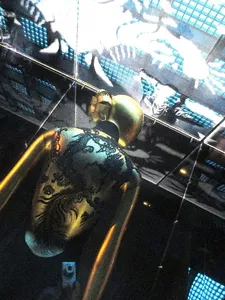 |
| Ralph Lauren evening dress: "Ralph Lauren has men usually in a country setting with a horse maybe." Photo: Anne-Katrin Titze |
Empire of Signs in the Asian Art Galleries "This exhibition is not about China per se but about a collective fantasy of China. It is about cultural interaction, the circuits of exchange through which certain images and objects have migrated across geographic boundaries. Moreover, it points to the aesthetic importance of exploring all the products of our cultural fantasies. As opposed to censoring or disregarding depictions of other cultures that are not entirely accurate, it advocates studying these representations on their own terms, appreciating them from the outset as having been infused with creativity, and discovering in this complex dialogue of elided meanings, a unified language of shared signs."
Anne-Katrin Titze: Look at this dress by Christian Dior. This is quite funny.
Gay Talese: It's very 1930s looking.
AKT: The calligraphy was chosen by Dior because it looks beautiful. It actually is a letter about a stomachache.
GT: If you didn't pay attention to the design, the calligraphy, you wouldn't think it's Oriental.
AKT: The cut you mean?
GT: Yes, the cut. You can see someone like Myrna Loy in a movie wearing that.
AKT: This one next to it is Chanel.
GT: You know, a Chanel jacket is like an Asian high-style uniform. The shoulders, the collar.
AKT: The black lacy back dress we saw in the Anna May Wong section reminded me of a dress from Jean Renoir's The Rules of the Game that Coco Chanel made the dresses for. It is the shot that introduces the mistress, played by Mila Parély.
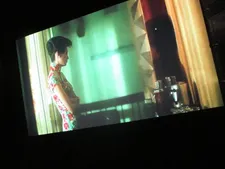 |
| Maggie Cheung in Wong Kar Wai's In the Mood for Love: "When we were watching the clip, I noticed that the man's jacket wasn't perfect." Photo: Anne-Katrin Titze |
We move on through porcelain to perfume and I point out a fragile pink embroidered dress by Callot Soers, who opened their atelier in Paris in 1895, and tell Gay about the Portfolio of twenty-one dresses of theirs featured in The New Yorker this March. While my mind wanders to the fleeting nature of fabric, Gay muses about gender difference.
GT: The sexes are so defined in one case by dressing up and in another case by dressing down. Women from the period of the Greeks dress up. There's something about the commercialization of the female form. The dressing up making it more desirable, therefore more able of choosing. How women's selectivity has to be preceded by their being attractive. And the amount of effort in the design of women's wear from the dark ages to the turn of the 21st century and where we are now is all in terms of a world of women alone.
Look at any day's newspaper. Look how the world is describing poverty, train wrecks, pestilence, disease, invasion by various killing groups, all that is there. But what is on the side? Women's dresses! It's an industry that transforms itself in times of peace and war. I mean, Chanel made a fortune from perfume. As beautiful as those jackets are, what is the perfume about? Allure, seduction. Fashion is seduction.
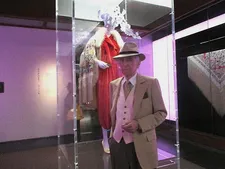 |
| Gay Talese in front of Paul Poiret's "Flammes" ensemble: "I'm an appreciator of those who care about appearances." Photo: Anne-Katrin Titze |
AKT: And men, you say, are about dressing down?
GT: Ralph Lauren has men usually in a country setting with a horse maybe. Maybe wearing, as he does, a leather fringy suede jacket with bluejeans and a cowboy hat. Or, men wearing 1930s style, almost gangster-ish double-breasted pinstriped suits that used to be worn by Edward G. Robinson in Little Caesar or people like Cesar Romero. Or 1940s actors: double-breasted, wide-shouldered, narrow-hip, with no vents in the back. Something brought back by Boardwalk Empire, that series on HBO. Some of the most beautiful dresses here come out of the 1920s and Thirties.
AKT: And war periods. When we were talking last week at the Morgan Library and you asked me what year Meet Me in St. Louis was made, before or after the war, we both could not imagine that it was 1944. But I really want to talk about your style. The way you dress is clearly not what you see a lot of on the street.
GT: Well, like you. I asked you a question I could ask myself.
AKT: Who do you dress for?
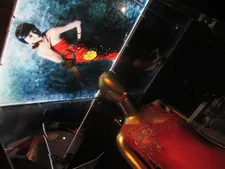 |
| Anna May Wong above House of Dior John Galliano haute couture dress Photo: Anne-Katrin Titze |
GT: I have a sense of self that's almost split. I have a sense of detachment from myself. I see myself as isolated. I see myself in third person. Sometimes I even write in third person. Gay Talese did such and such. I do see myself walking into a museum as now, how I look as I walk up the steps. It's not entirely conscious, that's much too simple. It is an awareness on two levels, how I feel about how I look. I'm 83. If you live in the East 60s, as I do, you're living among many doctor's offices that cater to people with illnesses. Many of them are aged patients that you see standing, looking for an address. And what do they look like? They look wretched! Dressed for death! They are so shabby, so unattractive and they feel awful. And look as bad as they feel.
And I myself walk among them and I'm older than they are. And I feel, 'if only you stupid people dressed better, you'd feel better.' I was thinking of starting a whole new movement, sponsored maybe by the medical profession, to appropriate money for old people with a wardrobe allowance and have designers like Brioni or Lord and Taylor devote enough of the profit to giving clothes to the ailing. Not the poor, to the ailing, and dress them up fashionably. If they looked better they would probably feel better. Because so much of fashion is about feeling better.
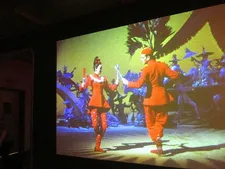 |
| Lucille Bremer and Fred Astaire in Ziegfeld Follies: "Fred Astaire is one of my favorites in terms of style." Photo: Anne-Katrin Titze |
AKT: When I wear a skirt that fits properly, I walk straight. If I wore a potato sack, I'd walk like this.
GT: I don't own a pair of blue jeans. I never have, never would. I don't dress down. Even when I'm working. I'm alone, nobody sees me for a long time, I wear a jacket. When I'm at home and I go across the street to buy a can of tomato soup at the Korean market on Lexington Avenue, a block and a half away, I dress up. Why? I feel that I have an image and that comes from being the son of a tailor who had an image. My father was a tailor, as you know, born in Italy. He came to America in 1920. I was born in 1932. In 1942, 43, 44, the Fascists are at war with the Americans. Italy is aligned with Hitler and Japan. And I felt in a Protestant American town with no Italians, no Italian neighborhood, that I was in alien territory. But my father being a man of appearances who dressed with care. He was always with a hat.
I have about 50 hats myself like this in different colours. And I got from him the necessity of appearances. Who you can be with the help of your clothes, with the help of how you wear them, how you walk and how you comport yourself. How you address people with a courtesy but never deferential and certainly never supplicating. How important it is to keep your distance and have a distant sense of self. I'm not ever unaware. When I'm interviewing people, I'm aware of a lot but I'm also aware of me interviewing people. I'm gaining from them a sense of what they are seeing. As they look at me looking at them.
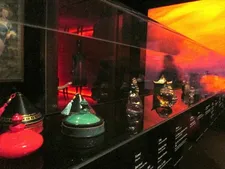 |
| Perfume flacons: On Chanel - "As beautiful as those jackets are, what is the perfume about? Allure, seduction. Fashion is seduction." Photo: Anne-Katrin Titze |
I'm an appreciator of those who care about appearances. Who recognise that appearances affect you psychologically. And as I make the reference to my age group - most of them are dead or crippled. Or they should be dead or crippled. I want to tell them "dress up!" Sometimes I'm in an elevator with them and it's awful to see them looking so awful in ways they could correct.
AKT: Do you plan your outfits in advance? How do you put it all together every day?
GT: I change my clothes sometimes three times a day. When I go out at night, it's most likely not what I wore at three o'clock in the afternoon. I change around six before going out to a book party or a dinner party. I have hand-made shoes that I wear usually at night. I have a lot of shoes that are the same design in different colours. Eleven pairs of shoes that are the same.
AKT: Do you have favourites? Certain things that are too precious to wear? A piece of clothing that you love so much that you only wear it for special occasions?
GT: That's interesting. That's true. I do have things that I wear very sparingly, very guardedly. Especially my shoes, if I think it's going to rain, I might select not my very best shoes.
AKT: Is it only dependent on the weather or could it also be dependent on people? Clothes as an armour?
_225.webp) |
| Moon In The Water reflected in China: Through the Looking Glass Photo: Anne-Katrin Titze |
GT: The other night, I went to the Ambassador from Jordan to the United Nations at her residence. I knew that there would be a bunch of United Nations people there. I always wear a dark suit, but I thought, I will not wear a gray pinstriped suit. I have a lot of Italian relatives in Paris and I get a lot of my clothes in Paris. This is a jacket I bought in Paris about ten years ago. Most of my clothes are Paris-made by relatives of mine. What they specialise in is the pinstripe that matches. If you look at a suit from the top and you look at the lines, sometimes the lines don't match. Their suits match like a German U-boat commander.
AKT: I will be very much aware of that from now on.
GT: Well, I didn't wear one of my exquisite suits. They're a little attention-getting or they might be. I do know some elegant people. Most of them are really foreign born. For example, when Ahmet Ertegun was alive. He used to be the head of Atlantic Records. When I was invited there I really dressed up for Ahmet Ertegun because he dressed up. When we were watching the clip, I noticed that [Maggie Cheung's] clothes fit perfectly, but the man's [Tony Leung] jacket wasn't perfect (Gay points to the back of the neck).
AKT: Let's go around the corner and look at Fred Astaire in Ziegfeld Follies.
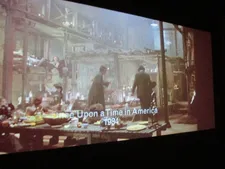 |
| Sergio Leone's Once Upon A Time In America opium den clip with Robert De Niro edited by Wong Kar Wai Photo: Anne-Katrin Titze |
GT: Fred Astaire is one of my favourites in terms of style.
AKT: I completely agree. Mine, too.
GT: Is that Cyd Charisse?
AKT: No, he is dancing with Lucille Bremer. Even dressed in "disguise" like this in the number Limehouse Blues from Ziegfeld Follies, every gesture gives him away as Fred Astaire.
GT: I'd love to see him in a suit and hat. He almost has the body of an Asian gentleman, very lean. Since he moved as a dancer so extravagantly, he is always jumping up and down, you notice how the suits don't jump. The body moves within the suit. Fred Astaire and the Duke of Windsor, they almost had the same body. They were short. When you look at the Duke of Windsor, everything was so perfect. Fred Astaire had really the look of elegance in the 1930s and Forties.
AKT: Did you ever meet Fred Astaire?
GT: No. I met Gene Kelly but I never met Fred Astaire.
AKT: Gene Kelly is the opposite in terms of style.
_225.webp) |
| Andrew Bolton's China: Through The Looking Glass at The Met Photo: Anne-Katrin Titze |
GT: Yeah. Gene Kelly could be a bouncer in a restaurant. The people who dress well… Tyrone Power, a name that means nothing now. Do you know the name Tyrone Power?
AKT: Of course I know Tyrone Power.
GT: He's one of my favorite looking men. And Marcello Mastroianni. When I got married in Rome in 1959, I met Marcello Mastroianni and Federico Fellini because they were doing La Dolce Vita that summer when I was there. I was very influenced by that Italian look.
We arrive back in the Anna May Wong section, Gay inspects the Travis Banton dress from the 1934 film Limehouse Blues, and we saunter out into the sun, towards The Carlyle for tea.
In part 1, Gay's travels to China, Edward Said, the Cultural Revolution, women's World Cup soccer, and Andy Warhol post-Mao at Andrew Bolton and Wong Kar Wai's China: Through the Looking Glass.
China: Through the Looking Glass is on view through August 16, 2015 at The Metropolitan Museum of Art.
Sargent: Portraits of Artists and Friends in the Iris and B. Gerald Cantor Exhibition Hall at The Metropolitan Museum of Art - June 30 through October 4, 2015.





















